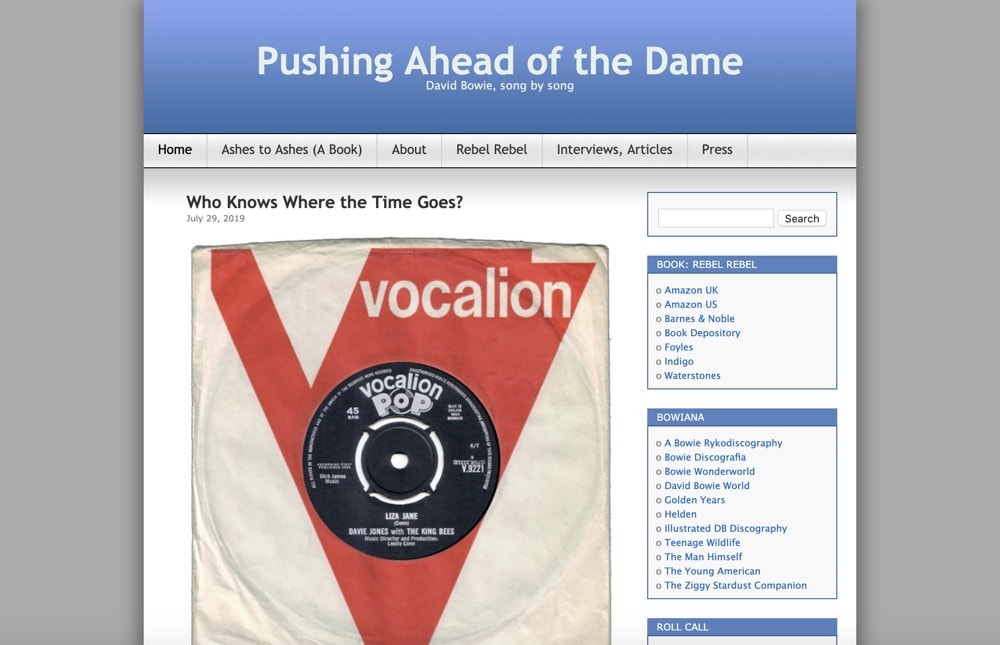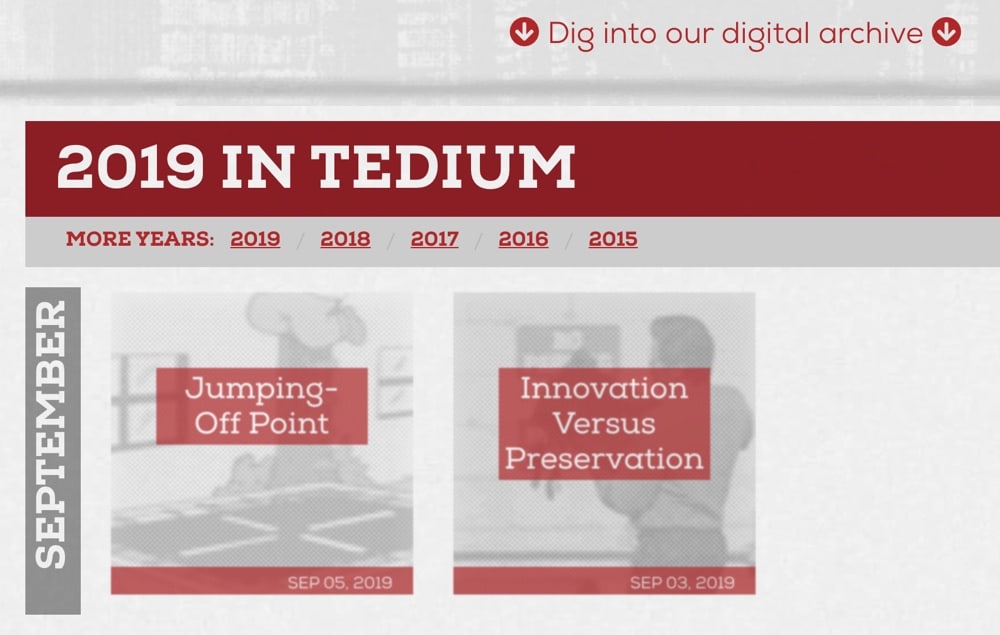Last week I argued that blogs, Tumblr and email newsletters can offer an alternative to the Black Mirror world of social media we currently live in. In particular, that we can build this new world – the blogosphere 2.0 – around cultural content.
Once again I have to caution: I don’t see this as competing with social media, because that horse has bolted. Rather, I see this as an alternative way to creatively spend time on the internet and meet other people passionate about the same topics as you. Which is something social media promised us it would do, back in Web 2.0, but utterly failed to deliver. However all is not lost, because blogs and newsletters can be the platform that we need to continue exploring and enjoying cultural content.
To move us forward, I thought it’d be useful to pick out some people who are already using blogging, Tumblr or email newsletters (or a combination of these tools) as a form of creative networking. I hope you find as much inspiration as I did in these folks.
Blogs
I’ll start with a blog I recently discovered about one of my all-time favourite musicians, David Bowie. Called Pushing Ahead of the Dame, it’s a WordPress blog written by Chris O’Leary and has been running for ten years now. The purpose of the blog is succinctly explained in its byline: “David Bowie, song by song.” Each post analyses, often in great detail, a specific song in the Bowie back catalogue. Using this as a template, O’Leary also delves into Bowie’s life, his evolution as an artist and how society perceived him at different times.
What started out in 2009 as a part-time blogging project was eventually turned into two books:
- Rebel Rebel: All the Songs of David Bowie from ’64 to ’76 (published 2015)
- Ashes to Ashes: The Songs of David Bowie, 1976-2016 (published 2019)
I just finished reading the second volume, Ashes to Ashes, and I really enjoyed it.
Although O’Leary revised and expanded the material, the structure of the books and most of the content derives from the blog.

What I love about this was that the blog format allowed O’Leary to immerse himself in a subject he was passionate about (Bowie’s music), creatively explore this topic over many years, and presumably connect with thousands of other Bowie or music fans in the process. Hopefully, the book royalties are compensating him for at least some of the many, many hours he poured into the project. But regardless, I’m sure he’s proud of the ten years worth of blog archives this project resulted in – not to mention all the people he’s met and interacted with along the way. Try getting that kind of satisfaction from being on Twitter or Facebook for ten years!
Since the Bowie blog is now effectively over – except for occasional future posts on Bowie reissues and unearthed demos – O’Leary has started a new blogging project this year. It’s another WordPress blog, called 64 Quartets. It looks to be another long-form project that may turn into a book. On his Patreon, he described his goal:
“A new blog that concerns, as the title suggests, 64 musical quartets. These will be rather long, or somewhat short, essays, each of which will have a discography and a dedicated playlist, whether on Spotify or YouTube or Soundcloud or other streaming mechanism.”
Subscribed!
Tumblr
One of the difficulties of using Tumblr in 2019 is that it’s hard to find Tumblr blogs to follow that are still regularly updated. As noted last week, Tumblr is past its heyday and its previous owners – Yahoo and then Verizon – halted what momentum the product had during the Web 2.0 era. But now that Tumblr has changed hands again, to WordPress owners Automattic, there is hope it can slowly rebuild momentum and rejuvenate its large user base (Tumblr has “more daily active users than WordPress.com has monthly active users,” Automattic CEO Matt Mullenweg said after the acquisition).
I still run a personal Tumblr blog, although (like many others) it had been neglected for a couple of years. I hadn’t posted to Tumblr since November 2017, until I heard about Automattic buying it. I’ve since started dabbling again, so we’ll see if that sticks.
Given I’ve highlighted a Bowie blog on WordPress, I decided to see what Bowie content was available on Tumblr.
As expected, I found a lot of Bowie images, GIFs, and links to his music and videos. This post, from the aptly named Bowie in Motion blog, is a good example. Since I can’t insert the post itself into this article, I’ve done a screenshot instead. But what you won’t see unless you click through to Tumblr is that each panel is a moving GIF. It’s a fun way to celebrate the Bowie of that era, and it’s what Tumblr is best at: multimedia posts that tell a kind of mini-story about a subject. As Bowie himself might have said, it’s all about the sound and vision.

After more searching, I did come across a Tumblr blog that has similarities with Chris O’Leary’s wordy WordPress blog. Bowie Tracks purports to be a “timeline of all of bowie’s singles, albums, videos, tv performances, radio sessions, and demos, as well as the most significant live recordings.” The blog had been dormant since April 2018, but has been re-started this month (perhaps after hearing about Tumblr’s new owners).
Although there is some good information in Bowie Tracks, it’s nowhere near as comprehensive or as interesting as O’Leary’s blog. Which I think illustrates a larger point: most people go to Tumblr for the multimedia. And, it should be noted, that format is ideal for celebrating cultural content – whether it be music, tv shows and movies, books, and so on. It’s no coincidence two of Tumblr’s most popular bloggers are musician Taylor Swift and author Neil Gaiman.
Tumblr is also potentially still the leading blog or email tool for social media-style engagement. 847 people have liked or re-blogged the Bowie in Motion post I mentioned above. That kind of engagement is hard to find on a WordPress blog these days.
Newsletters
I couldn’t find a Bowie newsletter, so I thought I’d highlight another book-related project. Houdini is a recently started Substack newsletter by author Joe Posnanski. He’s got a book coming out next month called “The Life and Afterlife of Harry Houdini,” so the newsletter seems to have been started to help promote that. Posnanski described it as:
“…my Houdini newsletter, where I will share all sorts of stuff about the book, about Houdini, about magic today.”
We’re all still learning about how newsletters are different from blogs. The method of delivery is the most obvious difference. Others include the way content is archived (blogs can do this better), the more direct connection that newsletters have with their readers (via email inboxes), and the ability for blogs to keep discussions on the website (whereas with newsletters, it’s more likely to happen on social media – if at all).

When it comes to the content though, there’s little difference between a blog post and a newsletter edition. Take Posnanski’s recent newsletter edition about meeting David Copperfield. It’s a personal, behind-the-scenes type narrative of how the author met one of the most famous magicians of this era for his book research. But this “insider stuff,” as Posnanski termed it, could just as easily have been written as a WordPress blog post.
What this tells us is that ultimately newsletters are the same as blogs, in terms of content – which is, after all, the most important thing. Tumblr on the other hand has its own unique style of content, which differentiates it from both traditional blogs and email newsletters.
Amalgam
Finally, it’s worthwhile looking at an example of how you can fuse together blogging with newsletters.
Ernie Smith has played in all three of these fields: blogs, Tumblr, and newsletters. His previous project was a Tumblr blog called ShortFormBlog, which covered news in a very Tumblr a.k.a. multimedia way. He shut down the site in 2014, but has recently revived it again.
Smith’s main project these days is Tedium, a twice-weekly email newsletter combined with blog. When I spoke to Smith earlier this year for my previous website Creator Interviews, he noted that the content is produced in one CMS and then output into two formats: email and website. The email newsletter is the primary product, but his blog post archive is also important – among other things, it attracts a decent amount of Google search traffic over time.

This is not dissimilar to what the email newsletter platform Substack offers; all editions of Cybercultural are also available on the Web as posts, for example. But since Smith rolls his own CMS platform, he has more control over his Web environment. For instance, he’s able to customise his archive and make use of tagging in his posts. Both things I’d love to do, but cannot at the present time.
Conclusion
Ultimately, each of the three platforms I’ve discussed has its strengths and weaknesses:
- Email newsletters are almost essential these days to reach an audience, since RSS Readers have largely died off and social media algorithms are too unreliable. However…
- Blogs still hold the advantage in building an archive, using open Web technologies like RSS, and having discussions onsite. However…
- Tumblr has very cool multimedia tools and a still large user base, which can help drive engagement. However, it’s not suited for long-form content…
Etc, etc. We can continue the pros and cons for a while, but in the end I think all three platforms can be used as complementary tools for our purpose: which is to explore and enjoy cultural content.
Finally, we’re currently living in a world where ideology trumps aesthetics – and yes, I used the ‘t’ word on purpose. We’re in this situation in large part due to social media. But cultural content is all about the aesthetics (hat-tip to The Bret Easton Ellis Podcast for ramming that point home regularly).
Art and culture is meant to be enjoyed and savoured, as well as make you think about the world from different viewpoints. Blogs and newsletters are the best online tools to help us do that.
Cross-posted from my Cybercultural newsletter.

